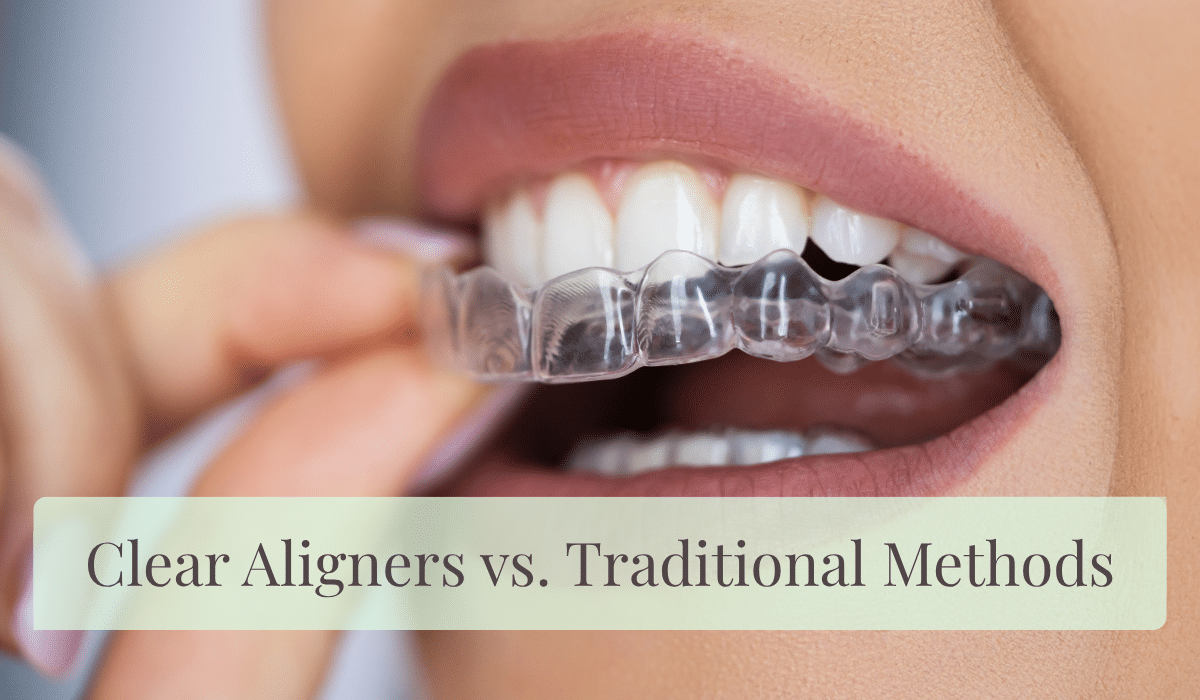Whether you are an adolescent or an adult that wants to have straighter teeth, you owe it to yourself to understand the differences between clear aligners vs. traditional methods. When it comes to teeth straightening solutions, they are not all created equal.
No matter which method of teeth straightening you choose, it’s important to note that it takes time. This means that whatever method you choose, it will likely be a long-term commitment. So, it only makes sense to do your research and choose the method that works best for you today, tomorrow, and even months from now.
Clear Aligners vs. Traditional Teeth Straightening Methods
There are two primary methods of teeth straightening:
- Clear Aligners. People who choose clear aligners essentially wear a translucent tray customized to fit their teeth and bite while also exerting pressure to assist with straightening them. These clear trays are removable so that the wearer can take them out when eating or brushing and flossing their teeth. This method is increasingly popular because the aligners are less noticeable to others.
- Metal Braces. For those who opt for traditional metal braces, it includes attaching metal brackets directly on the teeth and connecting them with wires to make one continuous thread of brackets. Small rubber bands help the brackets and wires stay connected and in place. Some patients may choose to call special attention to these rubber bands by changing the colors at appointments to be reflective of special holidays, school spirit, or just for fun.
While traditional braces are generally applicable for most people, a person’s eligibility for clear aligners may depend on the degree of alignment that needs to be done. A patient with intense overcrowding of teeth may or may not be eligible for clear aligners. Share your preferred method of aligning the teeth with your dentist and they will let you know if it will work for you.
Choosing Between Clear Aligners vs. Traditional Methods
The deciding factor for many people is that they don’t want whatever method they choose for aligning their teeth to be overly obvious to others. For many, this makes clear aligners the ideal choice.
For those that are still undecided which option might be best for them, the following considerations may be helpful in reaching a decision:
- Whether a patient chooses traditional braces or clear aligners, both typically require dental professionals to get an impression of the patient’s teeth.
- Metal braces are permanent and are glued into place. Once they are attached to the teeth, they stay in place until the teeth reach the desired degree of alignment. Clear aligners are not permanent and can be taken out to while eating and taking care of your oral health. It is important to note that they are only effective when they are being worn.
- Generally, wearers of both clear aligners and traditional braces will experience a slight initial speech impediment. For most patients, this is temporary and will go away during the course of treatment as they become increasingly used to the implements in their mouth.
- The longer you wear either metal braces or clear aligners, the more adjusting they will need as your teeth begin to align. The result of these continual adjustments will eventually result in the straightening and alignment of your teeth. However, there can be different routes in getting there. Metal braces are usually tightened or adjusted every month to two months at the dentist’s office. For aligners, rather than modifying them to make the teeth straight, each wearer gets multiple sets that they progress to every few weeks as their teeth come into better alignment.
- While clear aligner trays are not immune to breakage, traditional metal brackets are known to have occasional breakages in terms of brackets or wires. When these breakages occur, it requires a dental appointment as soon as possible so the teeth do not become misaligned. It may also be possible for breakages in metal braces to cause some degree of pain or sores for patients if it results in sharp edges that irritate the sensitive tissue in the mouth.
- Degree of difficulty in cleaning. Clear aligners are removable to enable patients to more fully clean the surface of teeth and floss effectively in between. Being able to reach more surface area of the teeth may help keep plaque and tooth decay from forming. Since metal braces are not removable until the end of treatment, patients must learn to efficiently brush and floss their teeth despite the brackets and wires. This requires a certain level of dedication that may take longer than it did before and may also require a special type of dental floss for optimized cleaning.
- People who have clear aligner trays can and should remove them when eating and drinking. Removing the trays allows them to enjoy hard and sticky foods such as chips and taffy. Unfortunately, metal braces cannot be removed for eating and drinking which means wearers must take special care not to eat particularly hard or sticky foods that could cause damage to the brackets or wires.
- While clear aligners may be more expensive up front, some wearers may not need to wear them as long as metal braces, which may mean fewer dental visits in the long run. Metal braces often require less expense in the beginning.
- Rubber bands or elastics. Some patients may require additional pressure to help their teeth straighten properly. Patients wearing aligners and traditional braces may be required to wear elastics.
- Whether a patient chooses traditional metal braces or clear aligners, it is common for them to wear a customized retainer following treatment to prevent the teeth from moving back. Depending on the patient’s specific needs, the retainer may need to be worn day and night, or only at night while they are sleeping.
Are Clear Aligners vs. Traditional Methods a Better Option for You?
For people with crooked or misaligned teeth, the consideration of clear aligners vs. traditional methods should be discussed with a reputable dentist. The dentist will be able to examine your mouth, talk through the process with you, and determine which method of teeth straightening is the better option for you. Contact a reputable dentist today to begin your journey to a straight smile you can be proud of.
- How Can Cosmetic Dentistry Improve More Than Just Your Appearance? - December 5, 2025
- How to Choose the Best Shade for Veneers - October 8, 2025
- How Your Dentist Plans a Smile Makeover: Step-by-Step Guide to Your New Smile - September 2, 2025




